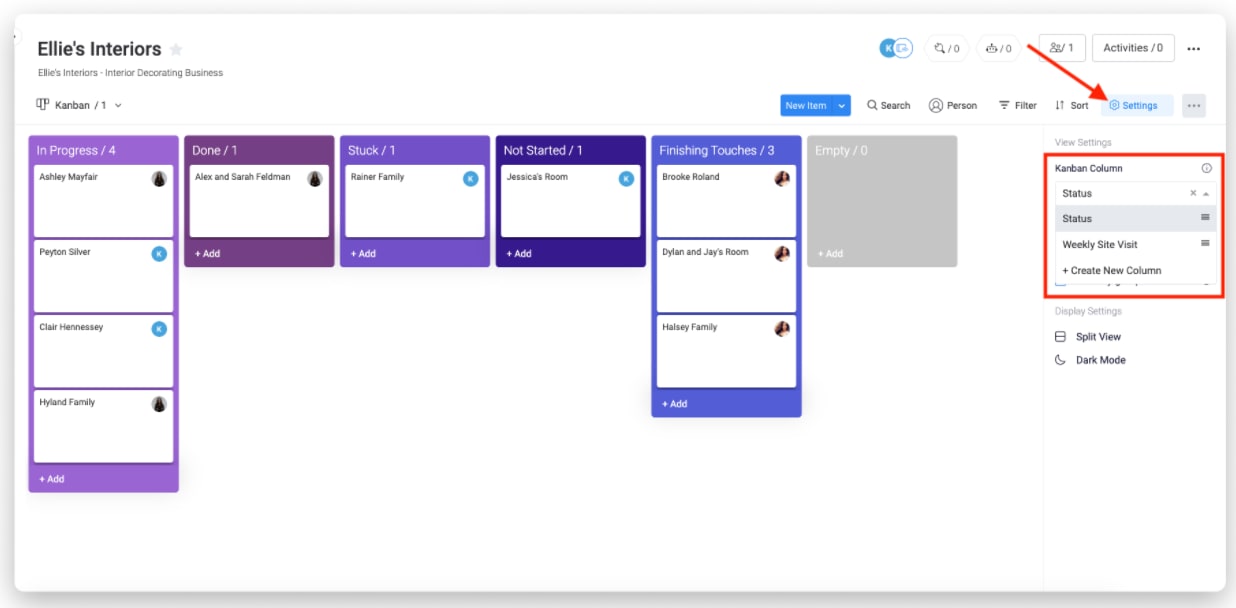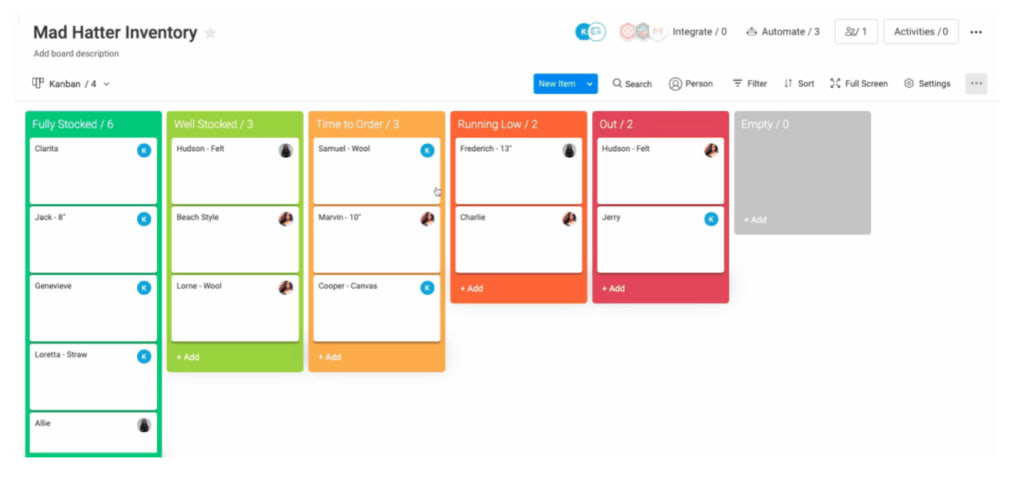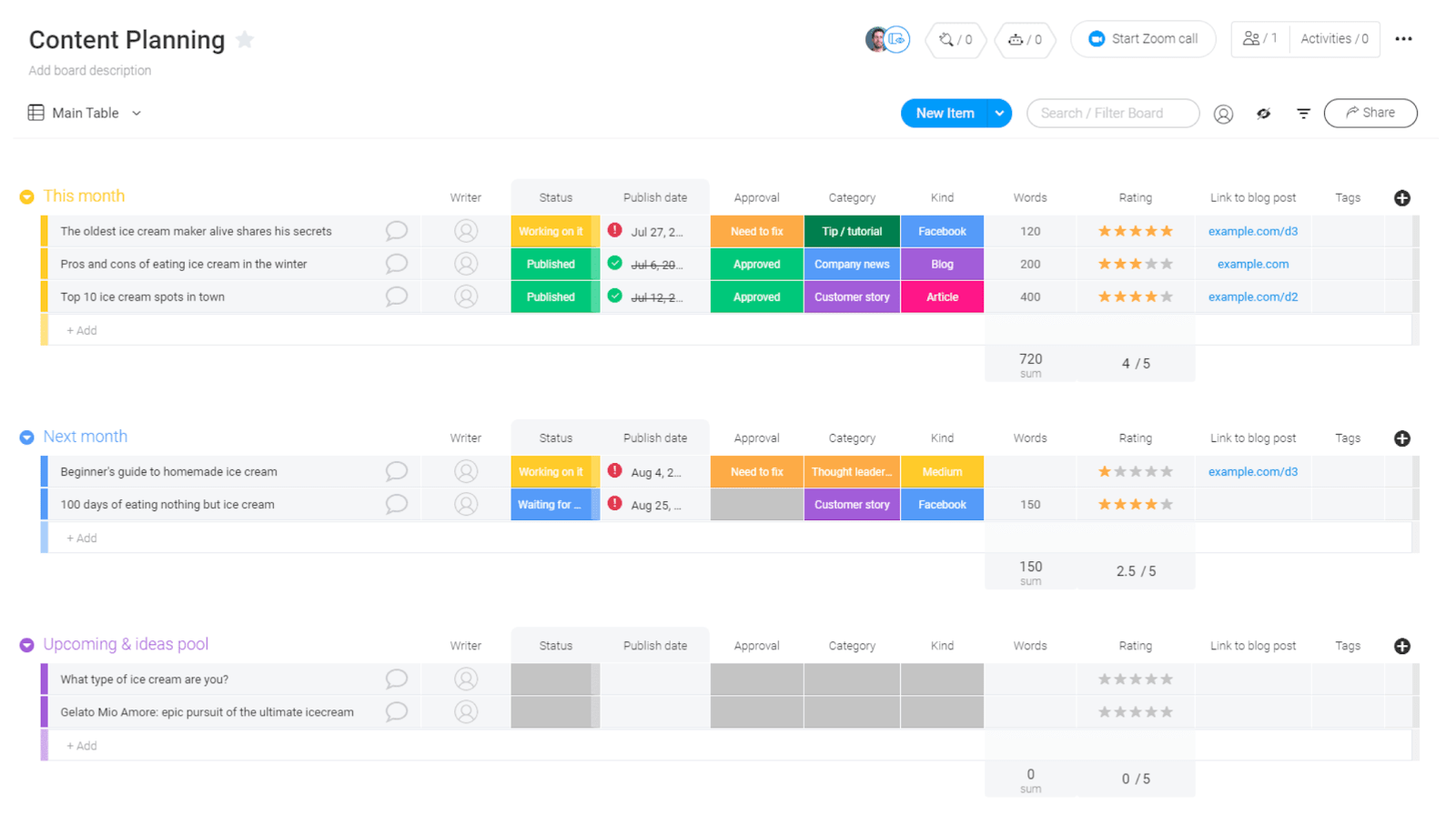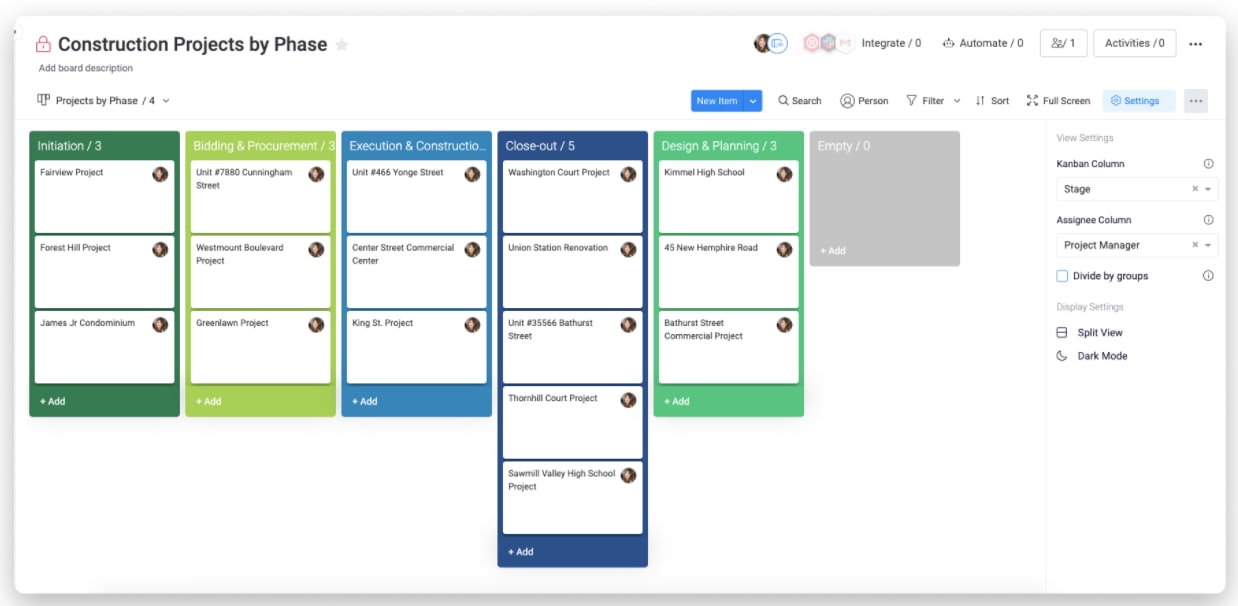Improving efficiency is a never-ending process. By making your workflows more efficient, you can save time, money, and other resources.
Kanban is an excellent way to do just that, as long as you structure your Kanban workflows the right way of course.
In this post, we’ll go over the principles of Kanban, and a few specific ways you can get started with Kanban boards easily.
What is Kanban?
Kanban project management is a methodology in which a project’s workflow is visualized and broken down into actionable pieces. Workers in a Kanban team are assigned to tasks and only have to worry about their own work.
Here’s an example of what a Kanban board looks like on monday.com:

Kanban boards make it easy to track project progress. They offer transparency into the project, so all teammates can see the project status at any time.
They’re also highly customizable so you can label and rearrange columns in whatever way works best for your needs.
A brief Kanban history
The word “Kanban” came into existence during the 1600s in Japan. It was a period of economic growth, which meant more stores on the streets. It also meant that store owners had to make signs to stand out from each other.
In Japanese, kan means “sign,” and ban means “board,” leading to the creation of signboards, or Kanbans.
However, its use as a project management framework has roots in the 1940s.
Taiichi Ōno at Toyota began streamlining Toyota’s processes to mimic those of a supermarket. He wanted Toyota to have just enough stock to meet demand, but not too much in order to cut costs that would otherwise go to excess inventory.
In other words, he wanted the Toyota production system to be a Lean manufacturing system.
To make this vision a reality, Toyota employees on the factory floor passed “Kanbans,” or cards, between each other with all the necessary information regarding the materials they needed.
Thus, Kanban as a project management visual framework was born.
What is the basic structure of a Kanban board?
Kanban boards divide your workflow into several steps, making it easy to visualize progress.
At the most basic level, Kanban boards have a 3-column structure.
These 3 columns are as follows:
- To-Do: lists all new ideas and work items that have yet to be worked on. If you have a blog post to write for the week, and you just came up with an idea for the topic, you’d stick it in the To-Do column.
- In Progress: represents all tasks currently being worked on. If you’re currently writing that blog post, it would be in the work In Progress column.
- Done: shows all tasks that have been completed. Once you finish writing that blog post, it would end up in the done column.
Kanban boards also have what’s known as a commitment point. The commitment point is where a task in the To-Do column is ready to be pulled into the In Progress column.
Of course, most organizations have more complex workflows than that. They’ll often create multiple columns under one of the 3 main columns.
How to use Kanban for project management
Once you’ve decided that Kanban is the way to go for your projects, you can set up and use a Kanban board by following these simple steps:
1) Choose your Kanban software
First, you must choose the right software.
No, that doesn’t mean the most expensive one, the one with the best looks, or the one that has a gigantic list of features.
You want software that’s customizable, visually appealing, and easy to use so you can get started instantly and start completing tasks.
Not to toot our own horn, but we think monday.com fits this list exactly 🙂
2) Create a project board
To create a Kanban board for your project on monday.com, you need to add a project board to your workspace.
This board can be used to list and group all your tasks. You can add columns for deadlines, status updates, team members, priorities, or any other details you’d like.
Once you’ve added all your tasks, you can use the Kanban view to get things rolling.

This automatically converts your project board into a Kanban one, where tasks and processes are divided into lists and columns. With monday.com you can then customize your columns to best suit your workflow.

3) Add cards
Add as many task cards as you’d like into their respective columns.
You can add detailed task descriptions, checklists, images, and files, and also assign each task card to multiple team members. To boost collaboration, you can add comments to task cards so team members can talk in context.
Now that you’ve made your first Kanban board, want to gain some inspiration about how different industries use Kanban?
Structure your Kanban board depending on your need
There are plenty of Kanban solutions available, but many of them don’t go beyond Kanban boards and maybe 1 other view.
monday.com on the other hand, has full online Kanban board functionality, but also comes with a full suite of project management features and 8+ views on top of its Kanban offering.
Let’s look at how you can use monday.com to structure your Kanban boards for 4 different industries:
Retail
Kanban was invented to more efficiently manage inventory, so it makes perfect sense to use it in a retail setting for inventory tracking.
However, the columns won’t be the traditional To-Do, In Progress, and Done. Instead, you could make each column a different level of stock.
On the far left, you have your fully-stocked goods. As the board moves right, the column represents a lower level of stock, including the furthest column representing the stuff you’re completely out of.

In this case, team members are assigned to each product to help split up work evenly and increase accountability in the company.
Content planning
Content planning lends itself well to Kanban. After all, a successful content strategy involves planning and tracking several content pieces at once.
Split your To-Do column into 2 sub-columns: one for content pieces you’ve planned out ahead of time, and another for those spontaneous ideas that pop into your head.
Have a commitment point after this first column. Split the In Progress column into sub-columns for outlining, writing, editing, and similar tasks — or however your team does its content marketing.
You can also add another column for design if it’s a lead magnet or other visual content pieces such as infographics.
Toward the end of your board, have a column for promotion. This column can represent content pieces that have yet to be shared through your various digital marketing channels.
Using monday.com’s content planning template, you can get started in a matter of minutes.

Construction project management
Construction projects have long timelines and a lot of moving parts. A Kanban tool helps you visualize such a complex process more easily.
For construction projects, you could make each entire project one card, or make every column a project phase, as seen in the image below.

On monday.com, you can assign people to each card as well. In the case of construction, assign project managers to their respective projects.
Now you know who to contact for project updates.
Software development
Kanban is perfect for Agile developers, since it supports the principles and values of the Agile methodology.If you’re looking at your company’s software development from a high level, a good way to arrange your board would be to make each project a card. The columns are the various development stages (design, development, testing, and so on).
Perhaps you’re looking at a specific software project, though. You could follow the same structure, but instead make each card an individual feature of the software.
Additionally, you should add a backlog column before the To-Do column for your backlog items. When you’ve ironed out how a backlog item can fit into a software product, you can move that item’s card to the To-Do column.
You know that monday.com’s Kanban view is simple yet effective, but did you know that monday.com allows you to turn your regular board into a Kanban board?
This board uses status columns as Kanban-style columns. All the items on the left are individual projects.
As a project moves through each phase, you simply flip its status to Done, so you can see the status of each project within a column at a glance. If a project is “stuck,” you can investigate why and solve the issue.
Visualize your work with Kanban and get more done
Kanban increases workflow transparency and makes it easy to improve efficiency.
monday.com does Kanban as well as most standalone solutions on the market. Yet monday.com offers all the other stuff you’d want in a Work OS, including a wealth of additional views.
Sign up for monday.com today to try it out for yourself and create your own cumulative flow, no credit card required!
FAQS
What is a Kanban flow?
A Kanban flow refers to the visual representation of tasks and their movement through different project stages. It highlights the progress of tasks from one column to another, showing a clear path of how work is being completed. This flow helps teams visualize bottlenecks, monitor progress, and maintain a smooth workflow.
What is a Kanban workflow?
A Kanban workflow is a system that visually organizes and tracks the flow of tasks across various stages of a project. The workflow is often displayed as a Kanban board with columns representing each stage of the process, from "To Do" to "In Progress" and "Completed." Teams use this workflow to manage tasks, limit work in progress, and optimize efficiency.
What are the 6 rules of Kanban?
The 6 rules of Kanban are designed to improve workflow efficiency and ensure continuous delivery. They include:
1. Visualize the workflow. Use a Kanban board to represent the workflow stages and tasks.
2. Limit work in progress (WIP). Set limits for how many tasks can be in each stage at a time.
3. Manage flow. Continuously monitor and improve the flow of tasks.
4. Make process policies explicit. Clearly define rules and processes for each workflow stage.
5. Implement feedback loops. Regularly review and adjust processes based on feedback.
6. Improve collaboratively, evolve experimentally. Continuously improve processes with team involvement and experimentation.

